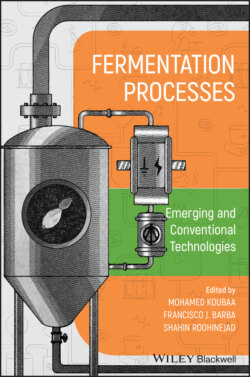Читать книгу Fermentation Processes: Emerging and Conventional Technologies - Группа авторов - Страница 21
1.2.2.3 Electron Transport Chain and Oxidative Phosphorylation
ОглавлениеIn a process called oxidative phosphorylation, the energy stored in the reduced coenzymes (NADH and FADH2) is released to produce ATP molecules. During this process, each coenzyme is oxidized and gives its two energy‐rich electrons to an electron transport chain, or respiratory chain, located in the plasma membrane in prokaryotes and the inner membrane of mitochondria in eukaryotes. The chain consists of complex organic acceptors that transfer electrons through a series of redox reactions (Figure 1.3). As the electrons are transferred in this chain, the energy that they contain is released by stages and is used to activate chemiosmosis. This creates a gradient of H+ protons whose energy is reinvested, through the enzyme ATP synthetase, in the production of three molecules of ATP per molecule of oxidized NADH and two molecules of ATP per molecule of oxidized FADH2. At the end of the transport chain, the electrons exhausted of their energy bond with O2 and H+ ions to form a water molecule. To summarize, for each glucose molecule that enters glycolysis, 34 molecules of ATP will be produced by oxidative phosphorylation (i.e. 30 molecules coming from NADH and 4 coming from FADH2). Further reading about the electron transport chain could be found in Campbell (2015).
Figure 1.3 The electron transport chain showing the respiratory complexes.
